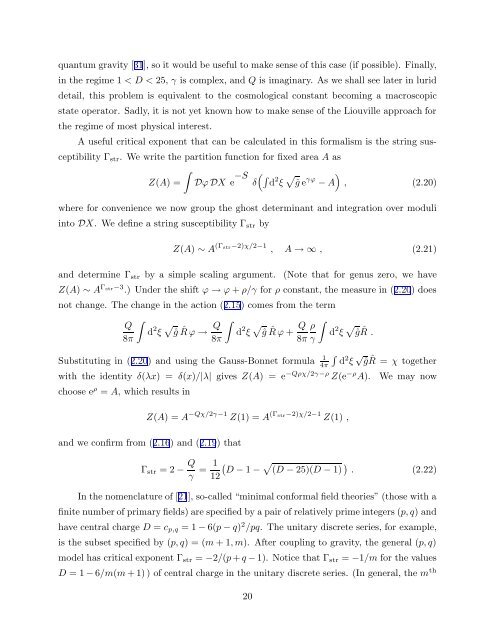arXiv:hep-th/9304011 v1 Apr 5 1993
arXiv:hep-th/9304011 v1 Apr 5 1993
arXiv:hep-th/9304011 v1 Apr 5 1993
Create successful ePaper yourself
Turn your PDF publications into a flip-book with our unique Google optimized e-Paper software.
quantum gravity [31], so it would be useful to make sense of <strong>th</strong>is case (if possible). Finally,<br />
in <strong>th</strong>e regime 1 < D < 25, γ is complex, and Q is imaginary. As we shall see later in lurid<br />
detail, <strong>th</strong>is problem is equivalent to <strong>th</strong>e cosmological constant becoming a macroscopic<br />
state operator. Sadly, it is not yet known how to make sense of <strong>th</strong>e Liouville approach for<br />
<strong>th</strong>e regime of most physical interest.<br />
A useful critical exponent <strong>th</strong>at can be calculated in <strong>th</strong>is formalism is <strong>th</strong>e string susceptibility<br />
Γ str . We write <strong>th</strong>e partition function for fixed area A as<br />
∫<br />
Z(A) = Dϕ DX e −S ∫<br />
δ(<br />
d 2 ξ √ )<br />
ĝ e γϕ − A , (2.20)<br />
where for convenience we now group <strong>th</strong>e ghost determinant and integration over moduli<br />
into DX. We define a string susceptibility Γ str by<br />
and determine Γ str by a simple scaling argument.<br />
Z(A) ∼ A (Γ str−2)χ/2−1 , A → ∞ , (2.21)<br />
(Note <strong>th</strong>at for genus zero, we have<br />
Z(A) ∼ A Γ str−3 .) Under <strong>th</strong>e shift ϕ → ϕ + ρ/γ for ρ constant, <strong>th</strong>e measure in (2.20) does<br />
not change. The change in <strong>th</strong>e action (2.15) comes from <strong>th</strong>e term<br />
∫<br />
Q<br />
d 2 ξ √ ĝ<br />
8π<br />
ˆR ϕ → Q ∫<br />
d 2 ξ √ ĝ<br />
8π<br />
ˆR ϕ + Q ∫<br />
ρ<br />
d 2 ξ √ ĝ<br />
8π γ<br />
ˆR .<br />
∫<br />
Substituting in (2.20) and using <strong>th</strong>e Gauss-Bonnet formula 1<br />
4π d 2 ξ √ ĝ ˆR = χ toge<strong>th</strong>er<br />
wi<strong>th</strong> <strong>th</strong>e identity δ(λx) = δ(x)/|λ| gives Z(A) = e −Qρχ/2γ−ρ Z(e −ρ A). We may now<br />
choose e ρ = A, which results in<br />
Z(A) = A −Qχ/2γ−1 Z(1) = A (Γ str−2)χ/2−1 Z(1) ,<br />
and we confirm from (2.16) and (2.19) <strong>th</strong>at<br />
Γ str = 2 − Q γ = 1 12(<br />
D − 1 −<br />
√<br />
(D − 25)(D − 1)<br />
)<br />
. (2.22)<br />
In <strong>th</strong>e nomenclature of [21], so-called “minimal conformal field <strong>th</strong>eories” (<strong>th</strong>ose wi<strong>th</strong> a<br />
finite number of primary fields) are specified by a pair of relatively prime integers (p, q) and<br />
have central charge D = c p,q = 1 − 6(p − q) 2 /pq. The unitary discrete series, for example,<br />
is <strong>th</strong>e subset specified by (p, q) = (m + 1, m). After coupling to gravity, <strong>th</strong>e general (p, q)<br />
model has critical exponent Γ str = −2/(p + q − 1). Notice <strong>th</strong>at Γ str = −1/m for <strong>th</strong>e values<br />
D = 1 − 6/m(m + 1) ) of central charge in <strong>th</strong>e unitary discrete series. (In general, <strong>th</strong>e m <strong>th</strong><br />
20
















